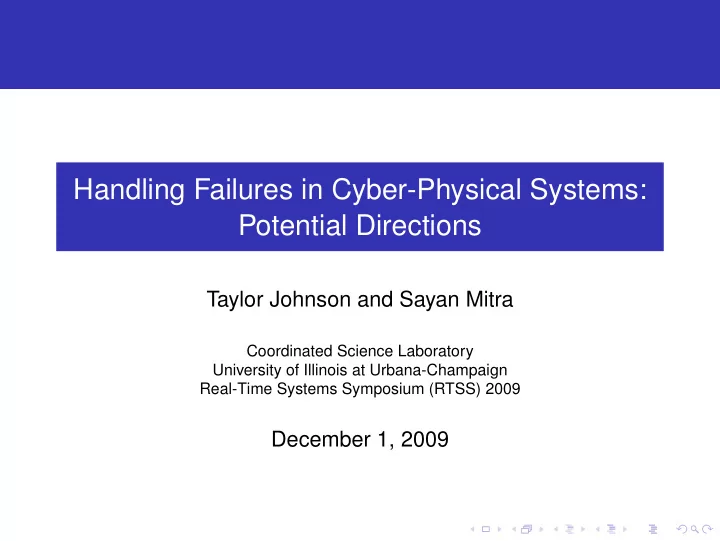

Handling Failures in Cyber-Physical Systems: Potential Directions Taylor Johnson and Sayan Mitra Coordinated Science Laboratory University of Illinois at Urbana-Champaign Real-Time Systems Symposium (RTSS) 2009 December 1, 2009
Motivational example from distributed computing Consensus (synchronous) Every process has an input and all non-faulty ones must decide on a common value in finite time
Motivational example from distributed computing Consensus (synchronous) Every process has an input and all non-faulty ones must decide on a common value in finite time in spite of failures processes (at least) rounds f crash failures f + 1 f + 1 t Byzantine failures 3 t + 1 t + 1
Motivational example from distributed computing Consensus (synchronous) Every process has an input and all non-faulty ones must decide on a common value in finite time in spite of failures processes (at least) rounds f crash failures f + 1 f + 1 t Byzantine failures 3 t + 1 t + 1 Natural question: how many processes are required to tolerate both f crash failures and t Byzantine failures?
Motivational example from distributed computing Consensus (synchronous) Every process has an input and all non-faulty ones must decide on a common value in finite time in spite of failures processes (at least) rounds f crash failures f + 1 f + 1 t Byzantine failures 3 t + 1 t + 1 Natural question: how many processes are required to tolerate both f crash failures and t Byzantine failures? CPS can suffer the previous failures and many more !
Motivational example from distributed computing Consensus (synchronous) Every process has an input and all non-faulty ones must decide on a common value in finite time in spite of failures processes (at least) rounds f crash failures f + 1 f + 1 t Byzantine failures 3 t + 1 t + 1 Natural question: how many processes are required to tolerate both f crash failures and t Byzantine failures? CPS can suffer the previous failures and many more ! Interdisciplinary research problem Develop failure detection and mitigation methods for cyber-physical systems
Outline Introduction 1 Research problem 2 Potential Directions 3
Cyber-physical fault interaction Safe cyber fault Physical state Unsafe
Cyber-physical fault interaction Safe physical fault Cyber state Unsafe
Cyber-physical fault interaction Safe Safe Safe Physical state Cyber state Cyber state physical cyber physical cyber fault fault fault Unsafe fault fault f fault Unsafe lt
Classes of failures Cyber (software) failures Distributed computing: crash; Byzantine General: bugs Real-time systems: timing (missing deadlines) Physical failures Sensor; actuator and control surface Robustness Failures between cyber and physical Communications Occurrence Single, permanent, transient, intermittent, or incessant
Prior work Example solutions Simplex architecture Giotto Etherware
Prior work Example solutions Simplex architecture Giotto Etherware Common theme: solutions through abstraction!
Handling failures: active versus passive Active (non-masking) Failure detectors Reliable failure detectors from unreliable processes ⇒ reliable systems from unreliable components (e.g., COTS, processes, stochastic processors, robustness, etc.)? Fault detection and isolation (FDI) Passive (masking) Redundancy from the consensus example Self-stabilizing algorithms ⇒ self-stabilizing systems?
Self-stabilizing algorithms fault fault closure Not Legal Legal convergence
Self-stabilizing systems? fault fault Good Poor performance performance performance performance convergence closure closure Safe
Formal methods and verification Motivation Why formal methods? Provable guarantees Successfully applied in a variety of problems Maturing tools and formalisms Useful concepts Abstraction Compositional reasoning Temporal logic and verification Actor model
Challenges and questions Model cyber and physical faults in such a way that they can be decoupled from one another, if possible Must make any solutions compositional to avoid explosion of interaction cases Complexity of analyzing all these fault sources simultaneously must be reduced: how does one fault influence another influence another is intractable Impossibility results Formal methods challenges ([Emerson, Clarke, and Sifakis, “Model checking: algorithmic verification and debugging”, Nov. 2009]): model checking for (a) software, (b) real-time systems, (c) hybrid systems, (d) probabilistic systems, and compositional model checking Lots of work to be done, but many interesting directions!
Thank you and questions Questions Hopefully there are lots of questions to motivate the discussion!
Recommend
More recommend